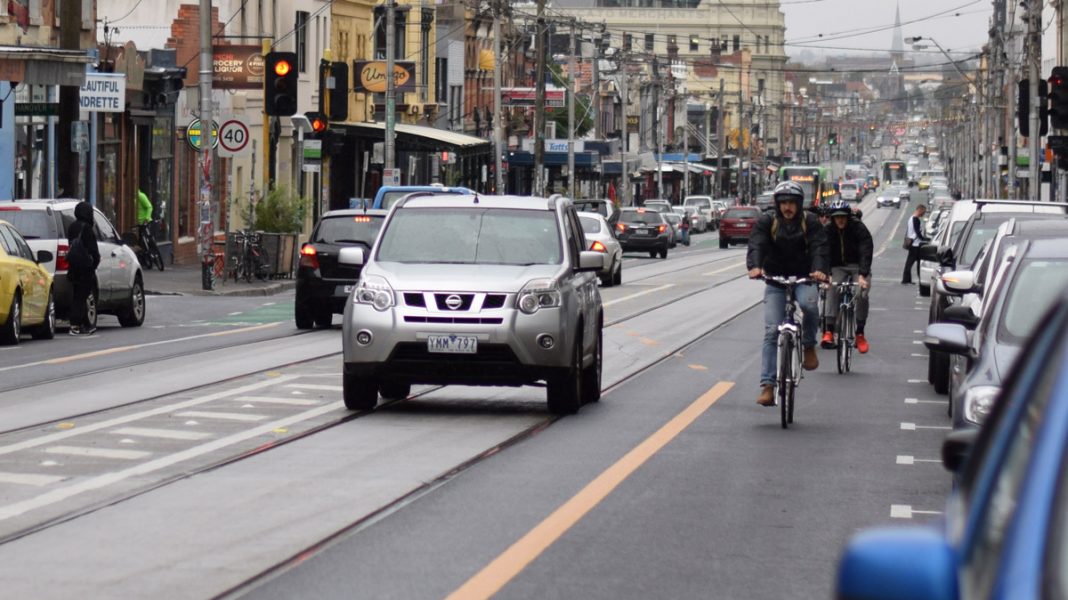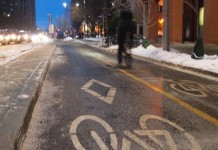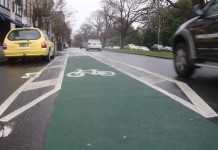Minimum passing distances are a step closer for Victorian cyclists after the State Parliament’s Economy and Infrastructure Committee today made 17 recommendations in support of a minimum passing distance for motor vehicles while overtaking and passing cyclists.
One of the recommendations is that motorists leave a distance of 1 metre in areas with a 60 kph or less speed limit, and 1.5 metres where there is a higher speed limit.
As well as those minimum passing distance recommendations there are recommendations regarding minimum bicycle lane widths, traffic conflict at high volume and narrow intersections and allowing motorists to cross the centre line to safely pass cyclists.
There’s also several recommendations about awareness and education like reminding motorists cyclists are permitted to ride two abreast, educating the police on understanding the new rules and encouraging empathy for cyclists.
One of the recommendations of the committee that may not be so popular with cyclists is that riders may not be able to ride two abreast at peak times on major arterial routes because it may be impossible for motorists to pass cyclists while maintaining the minimum distance.
The Greens introduced the Overtaking Bicycles Bill to Parliament last year and was sent to the Economy and Infrastructure Committee by the Government. The next steps to introducing the bill as law would be voting through the Legislative Council and the lower house.
There were 172 submissions from cycling groups, motorists, police and members of the public. You can view the full report and explanation of each recommendation of the Inquiry into the Road Safety Road Rules 2009 (Overtaking Bicycles) Bill 2015. The recommendations are summarised below.
RECOMMENDATION 1: That the Legislative Council amend the Overtaking Bicycles
Bill so that all references to “overtake” or “overtaking” are replaced by references to
“overtake or pass” or “overtaking or passing”.
RECOMMENDATION 2: That the Government consider the benefits of introducing
mandatory minimum traffic and bicycle lane widths for Victorian roads.
RECOMMENDATION 3: That the Legislative Council consider amending the
Overtaking Bicycles Bill to reduce potential conflicts arising from the interaction of
cyclists and vehicles at intersections, particularly intersections with high volumes of
bicycles and narrow roads, such as those in Melbourne’s central business district.
RECOMMENDATION 4: That the Legislative Council support changes to the Road
Rules requiring motor vehicles to leave minimum passing distances when passing
bicycles of:
(a) 1 metre in areas with speed limits of 60 kilometres per hour or less
(b) 1.5 metres in areas with higher speed limits.
RECOMMENDATION 5: That the Government undertake a communication campaign
to remind motorists that cyclists are permitted to ride two abreast and to encourage
cyclists to be courteous in riding two abreast by not doing so where it will slow
traffic down unnecessarily.
RECOMMENDATION 6: That, if specified minimum passing distances are introduced,
the Government erect signage at relevant locations recommending that cyclists ride
single files at specified times. Relevant locations would include high-volume arterial
roads where it may be impossible for motorists to pass cyclists riding two abreast
while maintaining the minimum passing distance.
RECOMMENDATION 7: That, if the Road Rules are changed to allow motorists to
cross centre lines when passing bicycles, the Government undertake research to
understand the risk posed to motorcyclists travelling in the opposite direction when
cars cross centre lines. Based on this research, the Government should develop a
strategy to mitigate this risk.
RECOMMENDATION 8: That the Legislative Council support changes to the Road
Rules allowing motorists to do the following when passing bicycles if safe:
(a) cross the centre of an unmarked two‑way road
(b) cross a dividing line separating traffic travelling in different directions
(including single lines, double lines, broken lines and continuous lines)
(c) drive on a dividing strip
(d) drive across the edge of a painted island
(e) cross lines separating lanes in a multi‑lane road (including continuous lines)
(f) drive over the edge line of a road.
RECOMMENDATION 9: That, regardless of whether or not the Overtaking Bicycles
Bill is passed, the Government undertake an education campaign to increase
motorists’ awareness of the safe distance to leave when passing bicycles. In
developing a campaign, the Government should build on the materials and learnings
from other Australian states and territories. The campaign should be developed with
VicRoads and the Transport Accident Commission, to draw on their expertise and
integrate the message with other road safety campaigns.
RECOMMENDATION 10: That, if specified minimum passing distance rules are
introduced, the Government amend learner driver materials and tests to reflect the
new rules.
RECOMMENDATION 11: That, if specified minimum passing distance rules are
introduced, the Government erect signs on key cycling routes and higher‑risk
locations to remind motorists of the rules. In developing the signage, the
Government should note research about changing driver behaviour to ensure that
the signs are as effective as possible.
RECOMMENDATION 12: That, if specified minimum passing distance rules are
introduced, the Government implement a training program for police designed to
ensure that police understand the reasons for the rules, to encourage empathy for
cyclists and to provide guidance as to what constitutes sufficient evidence to issue
an infringement notice.
RECOMMENDATION 13: That, if specified minimum passing distance rules are
introduced, the Government investigate technological solutions to assist with the
identification of offenders and the enforcement of the rules.
RECOMMENDATION 14: That, if specified minimum passing distance rules are
introduced, the Government task a suitable body with evaluating the impact of
the rules in Victoria. The learnings from the Queensland evaluation should be
taken into account in designing the Victorian evaluation. Among other things,
the evaluation should:
(a) compare driver behaviour and attitudes before and after the rules are changed
(b) identify any changes in cyclist behaviour as a result of the rule changes
(c) look for any impact on the risk of head‑on collisions from allowing motorists
to cross unbroken centre lines to pass cyclists (including accidents with
motorcyclists)
(d) consider the effectiveness of any education and awareness campaigns.
RECOMMENDATION 15: That, in considering the Overtaking Bicycles Bill, the
Legislative Council consider whether or not the Road Rules should be changed to
allow motorists to cross continuous yellow lines on the edges of tram lanes to pass
bicycles (so long as doing so is safe and does not obstruct trams).
RECOMMENDATION 16: That the Government consider ways to reduce the number
of bicycle accidents at intersections. This should include consideration of awareness
campaigns and infrastructure such as bicycle traffic lights.
RECOMMENDATION 17: That the Government establish a stakeholder group
including bicycle rider associations, other road user organisations, police and other
stakeholders. This group could provide advice and assist with the implementation
of specified minimum passing distance rules (if passed by the Parliament) and other
initiatives to improve cyclist safety on the roads.
If passed, the Overtaking Bicycles Bill will bring Victorian road rules into line with South Australia, New South Wales, the Australian Capital Territory and Queensland.
















